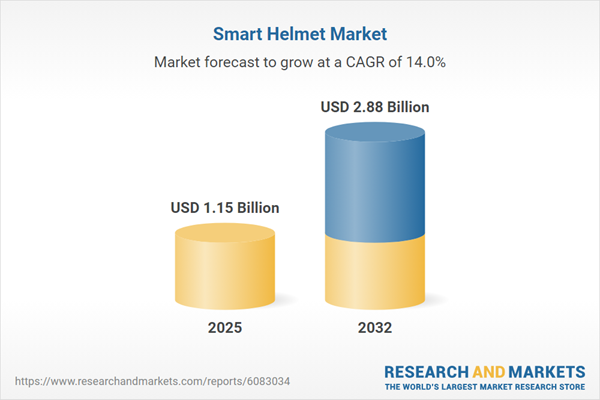Speak directly to the analyst to clarify any post sales queries you may have.
Smart helmet technology is reshaping industrial safety and operational performance by blending advanced connectivity features with reliable head protection. Senior decision-makers require clear market intelligence to guide investments and ensure long-term agility in this dynamic sector.
Market Snapshot: Smart Helmet Market Size and Growth Outlook
The smart helmet market is seeing strong momentum, with global revenue reaching USD 1.01 billion in 2024 and projected to grow to USD 1.15 billion in 2025. Forward-looking estimates suggest expansion to USD 2.88 billion by 2032, yielding a CAGR of 13.99%. Rapid advances in augmented reality, miniaturized sensors, and integrated communication platforms are positioning smart helmets as data-centric tools for real-time intelligence sharing and operational decision support. Market adoption spans diverse sectors: manufacturing, healthcare, defense, and recreation are integrating these platforms to elevate worker engagement, situational awareness, and efficiency.
Scope & Segmentation: Extensive Coverage Across Technologies and Use Cases
- Application Areas: Smart helmets are used across industrial workplaces such as construction, mining, and energy sectors; medical environments for monitoring and surgery; military settings for surveillance and command; recreational sports like cycling and skiing; and entertainment for experiences including AR tours and VR gaming. This broad adoption enables organizations to address multiple safety, productivity, and user engagement scenarios.
- Product Types: Market offerings include full face, open face, and half face helmet designs. Materials such as carbon fiber, fiberglass, and polycarbonate are used to optimize durability, comfort, and operator safety according to sector-specific demands.
- End Users: The primary users are industrial workers in factories and construction sites, law enforcement and security teams, military personnel across different units, and sports participants covering activities from cycling to motorcycling.
- Technology: Product platforms incorporate advances in augmented reality (including marker-based and markerless systems), gesture control, voice recognition, and multiple heads-up display formats, such as optical projection and combiner waveguides, to deliver dynamic and interactive user experiences.
- Connectivity: Both wired connections (HDMI, USB) and wireless protocols (Bluetooth, Wi-Fi) are standard, ensuring compatibility with a wide range of industrial and remote operational scenarios.
- Distribution Channels: The supply landscape includes offline distributors and specialty retail outlets, as well as digital channels ranging from company websites to third-party e-commerce, supporting flexible procurement choices.
- Price Ranges: Multiple price tiers are available, including high-end, mid-range, and value segment options, supporting varying organizational procurement strategies and budget requirements.
- Regions: This market features granular geographic insights, with segmentation into Americas (including North and Latin America), Europe, Middle East & Africa, and Asia-Pacific, supporting in-depth analysis of country-specific regulatory environments and adoption patterns.
Key Takeaways for Senior Decision-Makers
- Digital transformation and new connectivity standards are redefining helmets from passive protection to platforms for real-time monitoring, communication, and onsite collaboration.
- Modular product architectures and standardized technology interfaces encourage rapid feature customization and support integration with third-party tools, boosting innovation speed.
- Strategic partnerships in advanced materials, optics, and embedded software development are facilitating the production of lightweight, resilient, and highly interactive smart helmet systems suitable for use in challenging conditions.
- Regional adoption differs, influenced by factors including modernization policies in the Americas, defense priorities in EMEA, and infrastructure growth across Asia-Pacific.
- Supply chain strategies continue to evolve, emphasizing nearshoring and diverse sourcing models to safeguard continuity, minimize risk, and sustain reliable material flows.
Tariff Impact and Supply Chain Response
Recent tariffs in the United States on critical materials used in smart helmet manufacturing have raised import costs. As a result, producers are reevaluating their sourcing and production models, increasingly shifting supply bases toward local or treaty-compliant regions. This transition is aimed at strengthening operational resilience and reducing vulnerability to external supply shocks, though it may affect margins and delivery schedules. In response, companies are emphasizing procurement innovation, supply chain repositioning, and modernized processes to contain costs for buyers.
Methodology & Data Sources: Rigorous Market Research Foundation
This market assessment integrates primary interviews with senior executives and technical experts, supported by in-depth reviews of academic literature, patents, and industry sources. Findings are validated through data triangulation, supplier verification, trade statistics analysis, scenario modeling, and targeted expert workshops to deliver an objective, reliable view of the smart helmet market.
Why This Report Matters for B2B Strategy
- Supports investment decisions by clarifying key areas of opportunity, drivers of adoption, and primary market risks across the global smart helmet industry.
- Equips supply chain, compliance, and procurement teams with actionable insights for optimizing sourcing, adhering to regulations, and reducing risk in evolving market environments.
- Highlights opportunities for partnerships and innovation to enhance competitive positioning and deliver increased value through smart helmet solutions.
Conclusion
Adaptive strategic planning is critical as expectations and compliance requirements transform across regions. Organizations focusing on innovation and supply chain resilience will achieve greater competitive stability and successful smart helmet implementation.
Table of Contents
3. Executive Summary
4. Market Overview
7. Cumulative Impact of Artificial Intelligence 2025
Companies Mentioned
The companies profiled in this Smart Helmet market report include:- Honeywell International Inc.
- 3M Company
- Vuzix Corporation
- Blackline Safety Corp.
- TeamViewer AG
- Fortive Corporation
- RealWear Inc.
- Guardhat Inc.
- StrongArm Technologies Inc.
- Jarvish Inc.
Table Information
| Report Attribute | Details |
|---|---|
| No. of Pages | 194 |
| Published | October 2025 |
| Forecast Period | 2025 - 2032 |
| Estimated Market Value ( USD | $ 1.15 Billion |
| Forecasted Market Value ( USD | $ 2.88 Billion |
| Compound Annual Growth Rate | 13.9% |
| Regions Covered | Global |
| No. of Companies Mentioned | 11 |









